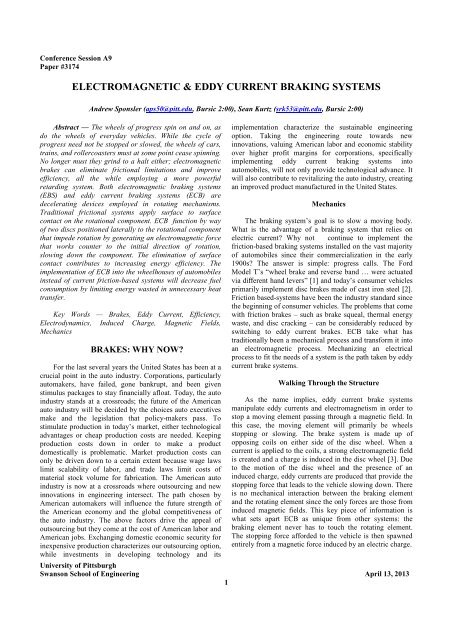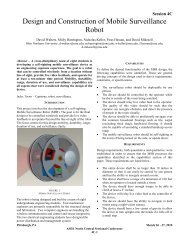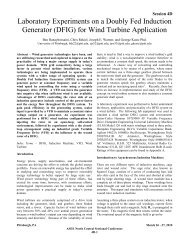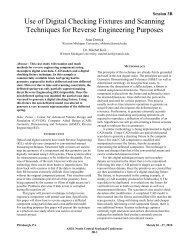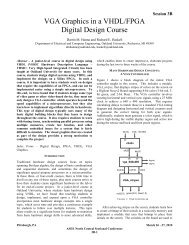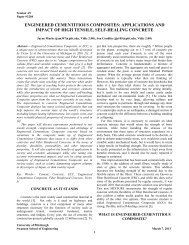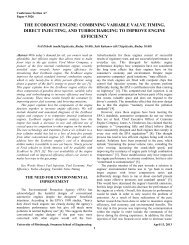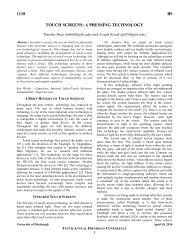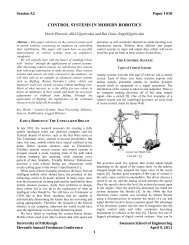ELECTROMAGNETIC & EDDY CURRENT BRAKING SYSTEMS
ELECTROMAGNETIC & EDDY CURRENT BRAKING SYSTEMS
ELECTROMAGNETIC & EDDY CURRENT BRAKING SYSTEMS
Create successful ePaper yourself
Turn your PDF publications into a flip-book with our unique Google optimized e-Paper software.
Conference Session A9<br />
Paper #3174<br />
<strong>ELECTROMAGNETIC</strong> & <strong>EDDY</strong> <strong>CURRENT</strong> <strong>BRAKING</strong> <strong>SYSTEMS</strong><br />
Andrew Sponsler (aps50@pitt.edu, Bursic 2:00), Sean Kurtz (srk53@pitt.edu, Bursic 2:00)<br />
Abstract — The wheels of progress spin on and on, as<br />
do the wheels of everyday vehicles. While the cycle of<br />
progress need not be stopped or slowed, the wheels of cars,<br />
trains, and rollercoasters must at some point cease spinning.<br />
No longer must they grind to a halt either; electromagnetic<br />
brakes can eliminate frictional limitations and improve<br />
efficiency, all the while employing a more powerful<br />
retarding system. Both electromagnetic braking systems<br />
(EBS) and eddy current braking systems (ECB) are<br />
decelerating devices employed in rotating mechanisms.<br />
Traditional frictional systems apply surface to surface<br />
contact on the rotational component. ECB function by way<br />
of two discs positioned laterally to the rotational component<br />
that impede rotation by generating an electromagnetic force<br />
that works counter to the initial direction of rotation,<br />
slowing down the component. The elimination of surface<br />
contact contributes to increasing energy efficiency. The<br />
implementation of ECB into the wheelhouses of automobiles<br />
instead of current friction-based systems will decrease fuel<br />
consumption by limiting energy wasted in unnecessary heat<br />
transfer.<br />
Key Words — Brakes, Eddy Current, Efficiency,<br />
Electrodynamics, Induced Charge, Magnetic Fields,<br />
Mechanics<br />
BRAKES: WHY NOW?<br />
For the last several years the United States has been at a<br />
crucial point in the auto industry. Corporations, particularly<br />
automakers, have failed, gone bankrupt, and been given<br />
stimulus packages to stay financially afloat. Today, the auto<br />
industry stands at a crossroads; the future of the American<br />
auto industry will be decided by the choices auto executives<br />
make and the legislation that policy-makers pass. To<br />
stimulate production in today’s market, either technological<br />
advantages or cheap production costs are needed. Keeping<br />
production costs down in order to make a product<br />
domestically is problematic. Market production costs can<br />
only be driven down to a certain extent because wage laws<br />
limit scalability of labor, and trade laws limit costs of<br />
material stock volume for fabrication. The American auto<br />
industry is now at a crossroads where outsourcing and new<br />
innovations in engineering intersect. The path chosen by<br />
American automakers will influence the future strength of<br />
the American economy and the global competitiveness of<br />
the auto industry. The above factors drive the appeal of<br />
outsourcing but they come at the cost of American labor and<br />
American jobs. Exchanging domestic economic security for<br />
inexpensive production characterizes our outsourcing option,<br />
while investments in developing technology and its<br />
implementation characterize the sustainable engineering<br />
option. Taking the engineering route towards new<br />
innovations, valuing American labor and economic stability<br />
over higher profit margins for corporations, specifically<br />
implementing eddy current braking systems into<br />
automobiles, will not only provide technological advance. It<br />
will also contribute to revitalizing the auto industry, creating<br />
an improved product manufactured in the United States.<br />
Mechanics<br />
The braking system’s goal is to slow a moving body.<br />
What is the advantage of a braking system that relies on<br />
electric current? Why not continue to implement the<br />
friction-based braking systems installed on the vast majority<br />
of automobiles since their commercialization in the early<br />
1900s? The answer is simple: progress calls. The Ford<br />
Model T’s “wheel brake and reverse band … were actuated<br />
via different hand levers” [1] and today’s consumer vehicles<br />
primarily implement disc brakes made of cast iron steel [2].<br />
Friction based-systems have been the industry standard since<br />
the beginning of consumer vehicles. The problems that come<br />
with friction brakes – such as brake squeal, thermal energy<br />
waste, and disc cracking – can be considerably reduced by<br />
switching to eddy current brakes. ECB take what has<br />
traditionally been a mechanical process and transform it into<br />
an electromagnetic process. Mechanizing an electrical<br />
process to fit the needs of a system is the path taken by eddy<br />
current brake systems.<br />
Walking Through the Structure<br />
As the name implies, eddy current brake systems<br />
manipulate eddy currents and electromagnetism in order to<br />
stop a moving element passing through a magnetic field. In<br />
this case, the moving element will primarily be wheels<br />
stopping or slowing. The brake system is made up of<br />
opposing coils on either side of the disc wheel. When a<br />
current is applied to the coils, a strong electromagnetic field<br />
is created and a charge is induced in the disc wheel [3]. Due<br />
to the motion of the disc wheel and the presence of an<br />
induced charge, eddy currents are produced that provide the<br />
stopping force that leads to the vehicle slowing down. There<br />
is no mechanical interaction between the braking element<br />
and the rotating element since the only forces are those from<br />
induced magnetic fields. This key piece of information is<br />
what sets apart ECB as unique from other systems: the<br />
braking element never has to touch the rotating element.<br />
The stopping force afforded to the vehicle is then spawned<br />
entirely from a magnetic force induced by an electric charge.<br />
University of Pittsburgh<br />
Swanson School of Engineering April 13, 2013<br />
1
Andrew Sponsler<br />
Sean Kurtz<br />
Moving Electricity<br />
The entire basis of the circuitry and construction of<br />
electrically actuated braking systems is in the concept of<br />
electric current. The formal definition of current is:<br />
= (1) [4]<br />
where i is current, q is charge and t is time [4]. Current is the<br />
change in charge over a change in time. Many of the<br />
relevant applications of electricity, such as the discovery of<br />
electromagnetism and induction of charge, have their roots<br />
in experiments with current.<br />
The entire notion of the feasibility of eddy current<br />
braking systems is predicated on the laws of<br />
electrodynamics. ECB use currents and induced magnetism<br />
to attract a rotating surface, thus slowing down a moving<br />
system [3]. The system relies heavily on the use of eddy<br />
currents to retard any given system.<br />
A note regarding the formal definition of current: in the<br />
context of electromagnetism, it is especially important to<br />
distinguish the definition of current to be a change in the net<br />
charge through an area. For example, take a solitary rod of<br />
copper and imagine a cross-sectional slice anywhere along<br />
the rod perpendicular to the length. Many electrons pass<br />
through this planar intersection at any given moment.<br />
However, since the electrons are passing through the plane<br />
in both directions, there is no net change in charge in any<br />
direction. If the same copper rod were attached to a rod, the<br />
presence of an electric potential would then create a flow of<br />
electrons through the cross-section and the rod would be said<br />
to be experiencing a current.<br />
Eddy Currents<br />
When a non-conducting material passes through a<br />
magnetic field, reactionary currents stir up beneath the<br />
surface of the metal. These circulating currents, called eddy<br />
currents, apply themselves against the magnetic field<br />
creating a force that is contrary to the field [4]. This<br />
principle is a product of Faraday’s law of induction.<br />
In order to provide a clearer basis of understanding, a<br />
brief overview of induction should be given consideration.<br />
Similar to an electric field, a magnetic field can pass through<br />
or be contained within an object. Thus how much of the field<br />
is contained within an object must be defined. The quantity<br />
of the magnetic field enclosed by an object is called the<br />
magnetic flux. The magnetic flux through area A is given by<br />
this equation.<br />
Φ = ⋅ (2)[4]<br />
Once the amount of magnetic flux has been<br />
quantitatively analyzed the flux equation can be used to<br />
formally state the Faraday-Lenz law of induction for a closepacked<br />
coil of N turns,<br />
= − (3)[4]<br />
The clearest example of an eddy current being induced<br />
in a conducting metal may be demonstrated by dropping a<br />
magnet through a vertically oriented copper pipe. The<br />
relative motion of the magnetic field, created by the magnet,<br />
past the conducting metal, the copper pipe, will create eddy<br />
currents inside the copper pipe and will slow the fall of the<br />
magnet. The magnet will quickly reach terminal velocity and<br />
will fall at a constant rate much slower than free fall. The<br />
currents are stirred up beneath the surface of the metal<br />
passing through the magnetic field. The swirling currents<br />
point in every direction in actuality; however, since the<br />
metal is in motion through the electric field, the only force<br />
that is “felt” is the force opposite of the direction of motion<br />
[5]. This antagonist force is the basis for an eddy current<br />
brake system.<br />
Levin et al. performed a study on eddy currents using<br />
the example of a magnet falling through a copper pipe to<br />
create an accessible model demonstrating Faraday’s theory<br />
of electromagnetic induction [5].<br />
FIGURE 1<br />
Diagram of elements involved in Levin’s experiment [5]<br />
In the study, a cylindrical magnet was dropped through<br />
a copper pipe of a certain radius. The study took record of<br />
the time the magnet took to travel through the length of the<br />
pipe. When a second magnet of equal mass to the first was<br />
attached to the first, the time required to travel through the<br />
pipe increased. It is assumed that a magnetically and<br />
electrically neutral object dropped through the copper pipe<br />
will have the fastest descent of all of these objects. From<br />
their measurements, Levin was able to calculate velocity,<br />
using the length of the pipe and the time of travel in the<br />
equation:<br />
= / (4)[5]<br />
University of Pittsburgh<br />
Swanson School of Engineering April 13, 2013<br />
2
Andrew Sponsler<br />
Sean Kurtz<br />
Levin then calculated a value qm by measuring the<br />
magnetic field in the center of one of the flat surfaces of the<br />
magnet and using that value in the equation of a magnetic<br />
field created between two discs within parallel planes of<br />
separation d.<br />
=<br />
! "# ! (5)[5]<br />
This formula implies that the force of attraction and<br />
consequently the eddy currents due to the induced field are<br />
related to the strength of the charge on the surface of the<br />
magnet. Since the charge can be manipulated by applying a<br />
current, the strength of the eddy currents within essentially<br />
any conducting element can also be manipulated.<br />
Electromagnetic brakes work by inducing current in a<br />
moving conducting loop. When electricity is applied to the<br />
ends of the brake coils a strong magnetic field is created in<br />
the space between. If the metal disc spins counterclockwise<br />
through the field, clockwise eddy currents are induced and<br />
the portion of the disc within the magnetic field experiences<br />
a force in the direction opposite of its rotation. The disc must<br />
then do work in order to continue rotating and will slow<br />
down. As Levin’s experiment demonstrated, the strength of<br />
the stopping force is proportional to the strength of the<br />
magnetic field, which is in turn dependent on the essentially<br />
limitless magnitude of the applied current. Since the strength<br />
of the force can be manipulated by adjusting the current put<br />
through an electromagnet, the strength of the magnetic field,<br />
and thus the stopping power of the brake, can be adjusted.<br />
Once paired with an operable foot pedal, this system<br />
becomes a variable pressure brake system.<br />
An Important Distinction<br />
Simply put, the terms “electromagnetic brake system”<br />
and “eddy current brake system” are not necessarily<br />
synonymous. While certain types of electromagnetic brake<br />
systems may induce eddy currents in the correlating metal<br />
conducting element, EBS are not the same as “eddy current<br />
brakes.” Electromagnetic brake systems employ<br />
electromagnetism to force the wheel and the brake element<br />
together to cause friction. An electromagnetic braking<br />
system sends a current through a coil of wire, creating a<br />
magnetic field to generate the mechanical force of friction,<br />
which is the source of the stopping power for the vehicle [3].<br />
Thus electromagnetic brakes are electromagnetic in their<br />
actuation but apply a torque mechanically. “Electromagnetic<br />
brake system” is a broad umbrella term categorizing brake<br />
systems that utilize electromagnetism. Eddy current brake<br />
systems are a subcategory of electromagnetic brake systems.<br />
Thus, EBS should be taken to mean the spectrum of brake<br />
systems actuated by electromagnetism, including, but not<br />
limited to, the eddy current system. When mentioned simply<br />
as EBS, it should be noted that in this instance the system<br />
referenced is one of electromagnetic actuation but that<br />
applies torque mechanically.<br />
FIGURE 2<br />
Basic schematic showing the discussed elements of an<br />
EBS system [3]<br />
Eddy current brakes are electromagnetic in their<br />
actuation as well as in their application of torque. A current<br />
runs through the magnetic coils generating a magnetic field<br />
which then induces a charge within the moving plate to<br />
create “eddy currents” within the plate. These eddy currents<br />
generate the stopping force for the system.<br />
Figure 2 shows an example of a brake system that<br />
applies torque mechanically. The coils can be seen<br />
positioned so that they can create an attractive force on the<br />
armature. The armature is connected to the brake pads, here<br />
labeled as friction disks, and braking power is applied to the<br />
wheel when the armature is forced into the wheel disc. The<br />
presence of a mechanical torque applicator implies that the<br />
diagram belongs to an EBS system.<br />
Applying Force without Contact<br />
The central reason for using EBS is to eliminate friction.<br />
Since friction in general wears away at a surface, there is a<br />
guarantee that a friction-based system will need to be fixed<br />
or replaced all together after some period of time. This<br />
assurance of breakdown implies maintenance costs. The<br />
implementation of a frictionless system in place of<br />
commonly used friction systems will lead to elongation of<br />
system life and better heat efficiency. Engineers must focus<br />
on new ways to make processes more sustainable and<br />
efficient, so ECB is a naturally sequential technology to<br />
implement as it does not involve friction-based retardation.<br />
Inducing eddy currents in the wheel disc to stop rotation<br />
creates little heat transfer. Thus, applying electromagnetic<br />
technology to brakes is an efficient way to improve energy<br />
use and reduce unnecessary heat loss.<br />
University of Pittsburgh<br />
Swanson School of Engineering April 13, 2013<br />
3
Andrew Sponsler<br />
Sean Kurtz<br />
Analysis of the stopping force provided by induced<br />
eddy currents proves to lend credibility to the system as a<br />
practical brake solution. Thompson presents an equation for<br />
the force generated by eddy currents [6].<br />
$ % = 2' %,)*+ , --./<br />
- ! " -<br />
! 0 (6)[6]<br />
./<br />
Describing this equation, Thompson says, “By<br />
Faraday’s law, there is an induced eddy current in the<br />
conducting fin, and these eddy currents generate a velocitydependent<br />
braking force fb, given by [equation] where v is<br />
relative velocity between the conductor and the permanent<br />
magnets, Fb,max is the maximum braking force; and vpk is a<br />
characteristic velocity at which the braking force peaks” [6].<br />
A major drawback and maintenance cost of frictional<br />
systems is the effects of the sizeable amount of thermal heat<br />
generated from the braking process. For instance, when a<br />
brake pad makes contact with a rotating brake disc, thermal<br />
energy is transferred directly to the metal disc. The thermal<br />
energy transferred causes the metal disc to expand. Once the<br />
energy has been sufficiently transferred to the surroundings,<br />
the metal disc contracts to its original size. Over time, this<br />
constant expanding and contracting can crack the metal<br />
brake disc. Once this occurs, the brakes’ integrity is<br />
compromised. The disc cannot properly work and can fail at<br />
any time given the specific conditions of operation. In<br />
contrast, eddy current brakes diminish the occurrence of this<br />
safety issue.<br />
One alternate situation that can arise occurs under<br />
constant braking. In time, thermal heat can be generated,<br />
though, at a slow rate. This case is not a main concern, but<br />
should still be kept in consideration. As a result, with the<br />
absence of friction, safety and accountability of the braking<br />
system is improved.<br />
Power Supply Critically Analyzed<br />
A natural question posed of the limitations of ECB is<br />
that of the source of power supplication. In the majority of<br />
automobiles, power is supplied by the ignition of gasoline or<br />
diesel fuel. Onboard electronics are supplied by means of an<br />
alternator, a device that converts mechanical energy into<br />
alternating electrical energy. A brake system that is actuated<br />
by an electric current would naturally tax the alternator<br />
heavily for how often brakes are used. A greater need for<br />
electrical power may necessitate more powerful alternators<br />
or additional battery cells to fuel brake function. The greater<br />
electric consumption may also mean that the system can<br />
only be implemented on electric cars that already generate<br />
enough current, or can be modified to generate enough<br />
current, to additionally supply power to the ECB. As<br />
insufficient experimental research has been performed on the<br />
subject of implementing ECB into automobiles, it is difficult<br />
to establish quantitatively the power demand versus stopping<br />
power of ECB systems or the feasibility of powering ECB<br />
through traditional automobile alternators.<br />
COMPARISON TO FRICTIONAL<br />
<strong>BRAKING</strong> <strong>SYSTEMS</strong><br />
Friction braking systems work by forcing direct contact<br />
between a moving surface and a fixed surface. The physical<br />
processes involved in this interaction are mechanical in<br />
nature. Since constant grinding occurs between the two<br />
surfaces, friction based brakes are not comparatively<br />
efficient – in terms of energy and heat application – to eddy<br />
current brake systems. ECB systems work through the use of<br />
applied electromagnetic fields without ever requiring<br />
physical contact between the disc wheel and the coils. The<br />
elimination of friction allows an increased timespan of<br />
utility and greater dependability.<br />
Advantages<br />
The primary advantages of applying EBS are reliability<br />
and efficiency. EBS will have to be replaced less frequently<br />
than friction based brakes, thus saving time and money in<br />
the long run. The applications of EBS are unlimited since<br />
they can be altered to meet a desired shape or size. Since<br />
EBS is a relatively young field, much advancement can<br />
easily be made through testing to find ways to make the<br />
product less costly. An additional factor to consider is the<br />
safety of EBS. The increased reliability and lack of surface<br />
contact leads to less chance of brake failure, overheating or<br />
slipping.<br />
The primary advantages of applying eddy current brakes<br />
to passenger vehicles include efficiency, safety, low<br />
pollution, and a low cost of maintenance. Since there is no<br />
direct contact between the moving body and the braking<br />
system, there is no deterioration of the braking system. ECB<br />
use electromagnetic forces to slow a moving body without<br />
creating much wasted energy. Even though thermal energy<br />
arises from the workings of the system, the waste is not<br />
close to traditional frictional systems that are in place today.<br />
Since ECB does not use friction, airflow or liquid coolants<br />
can easily cool the system without disturbing the braking<br />
process. The airflow and/or liquid coolants can absorb some<br />
of the thermal energy given off by the braking system,<br />
keeping the system stable. While in the frictional system,<br />
there is no room between the contact between the brake and<br />
the moving body causing constant wear on the system every<br />
time it is used. This direct contact friction also causes<br />
increased temperatures and is limited in functionality by the<br />
time of dissipation of the thermal energy. Friction-based<br />
braking systems function by transforming kinetic energy<br />
entirely into thermal energy [2]. One solution to the heat<br />
dissipation problem could be to use advanced engineering<br />
materials to construct lightweight, internally ventilated brake<br />
discs. Another solution would be to eliminate the direct<br />
University of Pittsburgh<br />
Swanson School of Engineering April 13, 2013<br />
4
Andrew Sponsler<br />
Sean Kurtz<br />
contact of brake pads entirely, using ECB. The disc brake<br />
system has an unstable nature when the concentration of heat<br />
becomes extreme. This leads to safety concerns in frictional<br />
systems that will fail above certain temperatures, while ECB<br />
can overcome these concerns since the temperature of the<br />
system can be controlled so that it does not rise appreciably.<br />
Installations of ECB can be one of two types: permanent<br />
magnet systems or charged systems. Permanent magnet<br />
systems have an inherent safety mechanism. These systems<br />
involve a magnet, commonly a neodymium-iron-boron<br />
magnet [6] that permanently generates a magnetic field. In<br />
this case the system works the same ways as the charged<br />
system with electric coils; however in this system the coils<br />
apply a magnetic field opposite of the permanent magnet so<br />
that when fully powered, the coils cancel out the magnetic<br />
field, creating a net magnetic field of zero. This way, if the<br />
system loses power, the magnet will automatically engage.<br />
Whether the system has power or the power fails, the brake<br />
will still work since the magnetism is constant. Charged<br />
systems, on the other hand, work like friction systems in the<br />
sense that they require power to slow a moving body. This<br />
charged system requires an emergency brake that can be<br />
applied in the chance that the power source fails. This<br />
emergency brake is most commonly a traditional friction<br />
brake that can be initiated through the use of a mechanical<br />
lever to apply braking force to slow the system. While, in a<br />
frictional case, normal friction applied brakes and<br />
emergency brakes can slip.<br />
Since eddy current brakes do not use direct contact,<br />
there is minimal chance that the system can fail or slip. The<br />
electromagnetic force is constantly applied during braking.<br />
A slip in a frictional system occurs when a horizontal force<br />
overcomes the force of friction. Since there is no contact in<br />
an ECB and since a constant electromagnetic field cannot<br />
slip, the system eliminates the chance of a situation where<br />
the braking can slip unintentionally. It must be noted that<br />
this reduction of slipping probability in the brake system<br />
does not preclude intentional engineering to provide for<br />
safety. Anti-locking safety features may be hardwired into<br />
the circuitry of the system to prevent tire skid or brake lock<br />
at high speeds or low-traction roadways.<br />
Another advantage of eddy current brakes is the<br />
minimization of pollution. The various forms of pollution<br />
related to traditional frictional braking systems include<br />
noise, smell, and physical waste. Debris from the brake in<br />
the contact area, thermal energy, and sound energy all result<br />
from the rubbing between the braking system and the<br />
moving body at the point of contact. As the brake pads are<br />
worn down, the material has to go somewhere, so the refuse<br />
usually turns into soil, air, and water pollution [7]. The<br />
thermal energy usually translates to create a burning smell<br />
not found in nature, creating air or odor pollution<br />
[7]. Lastly, the rubbing also causes various sounds of<br />
grinding, which is noise pollution [7]. Eddy current braking<br />
resolves the noise, odor and debris issues and is a green<br />
alternative. Since it lacks a frictional component, little<br />
energy is given off in the form of thermal pollution. The<br />
process is quiet and clean. No excess material is produced<br />
from the braking process and the only byproduct is a small<br />
quantity of thermal energy.<br />
In addition to being a green alternative, eddy current<br />
brakes require little maintenance. Foreseeable maintenance<br />
required for upkeep of the system would not be significantly<br />
more than coolant replacement and wiring replacement, and<br />
only infrequently through the life of the product. The life of<br />
the ECB system could foreseeably exceed that of the vehicle<br />
on which it is installed. Both wiring and coolant are<br />
inexpensive products and, if only purchased intermittently<br />
through the life of the product, would amount to low upkeep<br />
costs. Since the maintenance costs are so low, the cost of<br />
the installation and production of eddy-current brakes can be<br />
recouped over an estimated seven years, according to one<br />
study [8]. Life-cycle costs over a nominal 25 years are<br />
expected to be little more than half of those for conventional<br />
disc brakes [8]. While traditional friction brakes need<br />
consistent seasonal replacement of brake pads, braking fluid,<br />
and rotors, the long-run economic value of non-friction<br />
brakes overcomes the initial cost that the brakes require in a<br />
few years when compared to frictional systems.<br />
Disadvantages<br />
The problems facing the application of eddy current<br />
brakes are simply the time and cost associated with research<br />
and development of a system compatible with traditional<br />
automobiles. Since this is largely an experimental subject on<br />
systems as small and as ubiquitous as the common<br />
automobile, developers need to find the balance point<br />
between cost of production and marketability while still<br />
maintaining the quality of the product. A further aspect that<br />
disadvantages EBS is the need for the development of safety<br />
features analogous to anti-lock brakes in friction systems.<br />
The primary disadvantages of applying eddy current<br />
brakes to modern systems are: limited research, reliability at<br />
low speeds, and interference with other signaling<br />
processes. A search for information and statistics regarding<br />
the brake system yields few results because little field<br />
research has been done. This is a massive field where only<br />
general systems have been designed but minimal testing has<br />
been done beyond applications to trains, propellers, and<br />
roller coasters. This leads to unknowns in the everyday use<br />
of ECB for the common person, specifically in cars. Almost<br />
no studies have been done for real designs of ECB for<br />
consumer cars.<br />
One more concern of using eddy current brakes is their<br />
effectiveness at low speeds. Once a body’s motion has<br />
decreased, ECB almost become useless at slow speeds<br />
because nothing is there to hold the body at rest. Once the<br />
brakes have slowed the body down, there still needs to be a<br />
contact brake to hold the body in place. Then, when you<br />
turn the power off to the braking system, the body will be<br />
put back into motion by any force willing. Even the<br />
University of Pittsburgh<br />
Swanson School of Engineering April 13, 2013<br />
5
Andrew Sponsler<br />
Sean Kurtz<br />
permanent magnet system is unable to hold a body in<br />
place. ECB are excellent at slowing down high speed<br />
moving objects, but just have not been sufficiently<br />
developed to work at lower speeds. This is the main reason<br />
why ECB have not been used in cars, by assumption. The<br />
concept is promising, but there has not been enough research<br />
performed on the subject to find a way to apply the system<br />
to smaller moving bodies or bodies moving at low velocities.<br />
Another significant disadvantage to eddy current brakes<br />
is their studied interference with other signaling and electric<br />
parts of certain applications. Since this system relies heavily<br />
on magnetism, the fields in place by the brakes can alter<br />
other signaling processes. A study involving high-speed<br />
trains showed that several of the signaling grids were<br />
experiencing interference caused by the ECB system’s<br />
generated magnetic field, even while the ECB system was in<br />
the off position [8]. The permanent magnets involved in<br />
ECB may potentially pose hazards to sensitive medical<br />
equipment, such as pacemakers, as well as many other<br />
electronic devices that would be brought within a certain<br />
proximity to the car. This issue needs to be fixed before<br />
ECB can be used commercially.<br />
<strong>CURRENT</strong> USES OF EBS AND ECB<br />
Electromagnetism is not simply a way of the future for<br />
automobiles. The concepts may be applied to any technology<br />
with moving parts. Electromagnetic brakes in particular are<br />
already commonly used in industries such as production and<br />
transportation.<br />
• Copiers and printers<br />
• Packaging machinery<br />
• Conveyors<br />
• Textile machinery<br />
• Rollercoasters<br />
• High speed locomotives<br />
List of devices with EBS<br />
This list of devices represents the diversity of the utility<br />
of mechanically applied electricity. This list is limited and<br />
does not involve all systems currently in place.<br />
Sustainability<br />
A natural question posed of any aspiring technology is,<br />
“Is it sustainable?” The heart of this question is financial in<br />
nature – any investor would want to know if the advantages<br />
can quantifiably outweigh the disadvantages. Would an eddy<br />
current brake system viably afford a powerful retarding<br />
system, while functioning in a way so that energy or other<br />
material is not significantly depleted or wasted? The answer<br />
lies in practical examination of the torque applicator within<br />
the system. In ECB the torque is applied without physically<br />
contacting the disc wheel, applying torque solely with a<br />
magnetic field. Since there is no mechanical contact, there is<br />
no part to be worn down over time as quickly as the<br />
frictional system equivalent: the brake pad. The elimination<br />
of the brake pad in ECB limits the amount of material<br />
depleted by enabling the brakes. Also, the use of brake pads<br />
emits thermal energy from direct contact with the brake disc.<br />
The brake disc over time can crack from continuous braking.<br />
This part is another major component that needs to be<br />
replaced in traditional frictional systems that is eliminated<br />
by the use of an eddy current brake.<br />
The sustainable effect of switching to a system without<br />
brake pads and discs is clearly seen: first, less material is<br />
released as pollution and, second, there is no need to replace<br />
any brake pads and discs during the life of the system. In<br />
traditional friction-based brake systems, the application of<br />
the brake pad onto the brake disc generates the mechanical<br />
torque required to stop rotation. In the course of application,<br />
the brake pads are worn away and the material that is worn<br />
off must be deposited elsewhere. The dust given off of the<br />
brake pads is given off through the wheel well and released<br />
into the atmosphere. While the volume of material given off<br />
as dust due to a single vehicle may seem inconsequential, the<br />
net result of the pollution of all vehicular brake systems may<br />
adversely affect the environment. An advantage of<br />
eliminating the brake pads would be that the pollution due to<br />
wear and tear of the brake pads would also be eliminated. Of<br />
course, in a system without brake pads and discs, no brake<br />
pads or discs would need to be replaced. Therefore in the<br />
long-term the cost of maintenance is low compared to<br />
friction brakes since there are no parts that require as<br />
frequent replacement.<br />
Finances take a significant cut when eddy current brakes<br />
are implemented. The initial costs of ECB are more<br />
expensive than traditional systems. Though, in the long run,<br />
this new system pays for itself. In an estimated period of<br />
seven years, expenses for frictional systems surpass the ECB<br />
system. So, in the normal life span of a car, ECB would<br />
save the owner expenses on brakes past seven years. Also,<br />
the owner would not have to take the car in to exchange<br />
brake pads and to inspect brake discs every year, depending<br />
on the driver. The use of fuel can also be cut when installed<br />
in the car. ECB can use power from either the cars battery<br />
or another electrical power source. The application of this<br />
system to an electric car would be able to advance green<br />
technology already in place. Since ECB uses a magnetic<br />
field, energy is conserved compared to frictional systems<br />
that convert all of their energy to thermal heat. This thermal<br />
heat is then dissipated into the air surrounding the brake, in<br />
the frictional system. Thus, eddy current brakes do not give<br />
off excess energy. The use of eddy current brakes in cars is<br />
economically sound for the consumer in the long run and has<br />
the potential to outlive the rest of the car. This braking<br />
system does not develop new extra expenditures to be made<br />
University of Pittsburgh<br />
Swanson School of Engineering April 13, 2013<br />
6
Andrew Sponsler<br />
Sean Kurtz<br />
outside the upgraded braking system, based off of the<br />
research done as of recent.<br />
Ethics<br />
The fundamental canons set by the National Society of<br />
Professional Engineers [9] strictly convey how research and<br />
information distribution should be handled. The information<br />
presented has been confirmed by research. The intent of this<br />
development is to only advance the field of engineering and<br />
mechanics as a whole. Safety and waste is at the forefront of<br />
all concerns and the evaluation of the inherent risks that<br />
come with new developments. The potential development is<br />
to be an improvement on prior systems that are costly in the<br />
long run and cause unnecessary waste and pollution. This<br />
field still needs more research to provide more evidence for<br />
reliability, but there is a strong understanding of the topic.<br />
A Device for the Future<br />
While many devices take advantage of the concept of<br />
electromagnetism, the majority of automobile braking<br />
systems do not. When considering a design for a brake<br />
system in a product, automobile manufacturers should<br />
consider the option of eddy current braking systems. ECB<br />
are safe, responsible, and noiseless. Frictionless braking<br />
systems are a viable alternative to traditional friction-based<br />
systems. Continued research on this subject will only further<br />
strengthen the case for the implementation of ECB in<br />
automobiles.<br />
REFERENCES<br />
[1] Alizon, Fabrice, Steven B. Shooter, and Timothy W.<br />
Simpson. "Henry Ford and the Model T: Lessons for Product<br />
Platforming and Mass Customization." Elsevier Ltd., 5 Sept.<br />
2009. Web. 3 Mar. 2013.<br />
.<br />
[2] Krenkel, Walter, Bernhard Heidenreich, and Ralph Renz.<br />
"C/C-SiC Composites for Advanced Friction Systems."<br />
Advanced Engineering Materials. WILEY-VCH Verlag<br />
GmbH, 7 May 2002. Web. 4 Mar. 2013.<br />
.<br />
[3] "Multiple Disc Electromagnetic Brake." Ogura<br />
Industrial Corp. Ogura Industrial Corp., n.d. Web. 07 Mar.<br />
2013. .<br />
[4] Halliday, D., R. Resnick, and J. Walker. Fundamentals<br />
of physics. 9th. Wiley, 2011. Print.<br />
[5] Levin, Yan, Fernando L. Da Silveira, and Felipe B.<br />
Rizzato. "Electromagnetic Braking: A Simple Quantitative<br />
Model." Instituto De F ísica, Universidade Federal Do Rio<br />
Grande Do Sul, 2 Feb. 2008. Web. 4 Mar. 2013.<br />
.<br />
[6] Thompson, Marc T. "Practical Issues in the Use of<br />
NdFeB Permanent Magnets in Maglev, Motors, Bearings,<br />
and Eddy Current Brakes." Proceedings of the IEEE 97.11<br />
(2009): 1758-767. Print.<br />
[7] Gammon, Katharine. "Pollution Facts | Types of<br />
Pollution." LiveScience.com. TechMediaNetwork.com, 27<br />
Aug. 2012. Web. 05 Mar. 2013.<br />
.<br />
[8] Schykowski, Jennifer. "Eddy-current Braking: A Long<br />
Road to Success." Railway Gazette. DVV Media UK Ltd., 2<br />
June 2008. Web. 5 Mar. 2013.<br />
.<br />
[9] "NSPE Code of Ethics for Engineers." NSPE Code of<br />
Ethics for Engineers. National Society of Professional<br />
Engineers, n.d. Web. 01 Feb. 2013.<br />
.<br />
ADDITIONAL SOURCES<br />
Adly, A. A., and S. K. Abd-El-Hafiz. "Speed-Range-Based<br />
Optimization of Nonlinear Electromagnetic Braking<br />
Systems." IEEE Xplore. IEEE, n.d. Web. 01 Feb. 2013.<br />
.<br />
Albertz, D., S. Dappen, and G. Henneberger. "Calculation of<br />
the 3D Nonlinear Eddy Current Field in Moving Conductors<br />
and Its Application to Braking Systems."IEEE Xplore. IEEE,<br />
n.d. Web. 01 Feb. 2013.<br />
.<br />
Antipova, N. A. "The use of an electromagnetic brake to<br />
improve the dynamic stability of a power system - Springer."<br />
Home - Springer. Springer, May 2012. Web. 16 Jan. 2013.<br />
.<br />
Asai, S. "Recent Development and Prospect of<br />
Electromagnetic Processing of Materials."IOP SCIENCE.<br />
Elsevier Science Ltd., n.d. Web. 1 Feb. 2013.<br />
University of Pittsburgh<br />
Swanson School of Engineering April 13, 2013<br />
7
Andrew Sponsler<br />
Sean Kurtz<br />
.<br />
DLA History - About the Scholarly Communications Project<br />
and the Digital Library and Archives, University Libraries,<br />
Virginia Tech. N.p., n.d. Web. 16 Jan. 2013.<br />
.<br />
"Ethics." ASME. ASME Standards Technology, LLC, 10<br />
Sept. 2007. Web. 16 Jan. 2013.<br />
.<br />
Kinkaid, N. M., and O. M. O'Reilly. "Automotive Disc<br />
Brake Squeal." ScienceDirect.com. Department of<br />
Mechanical Engineering, University of California -<br />
Berkeley, 9 Oct. 2003. Web. 07 Mar. 2013<br />
"Telma Frictionless Braking Systems." Telma. Parallax<br />
Inc./IMA Consulting, n.d. Web. 16 Jan. 2013.<br />
.<br />
ACKNOWLEDGMENTS<br />
We would like to thank Matt Bogolin and Khaled<br />
Abdelrahman for their help in the revision process. Sean<br />
would like to specifically thank Samantha Margaret Durham<br />
for her inspiration. Thanks to Antony Gnalian and Paul<br />
Snyder, you guys are the best. Last but not least, thank you<br />
to our parents.<br />
University of Pittsburgh<br />
Swanson School of Engineering April 13, 2013<br />
8


